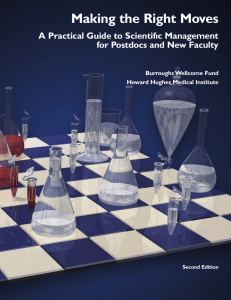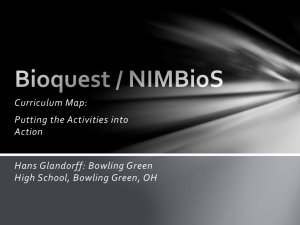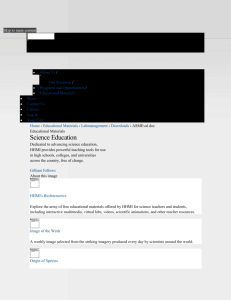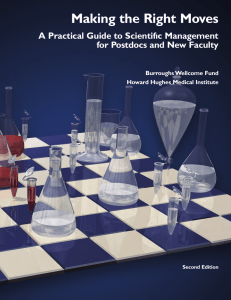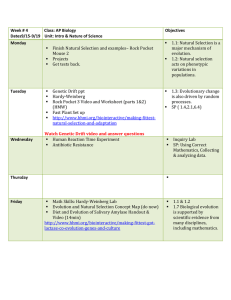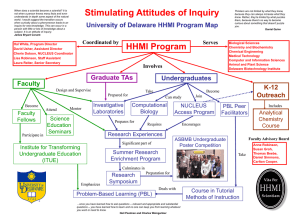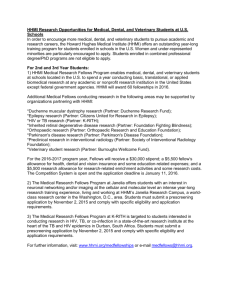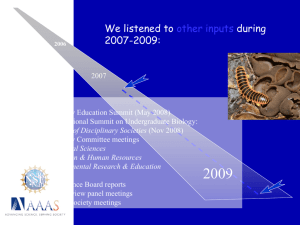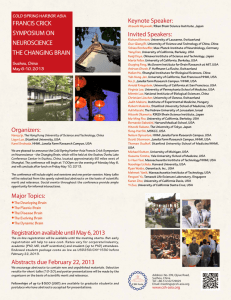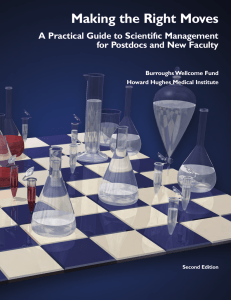Making the Right Moves A Practical Guide to Scientifıc Management
advertisement
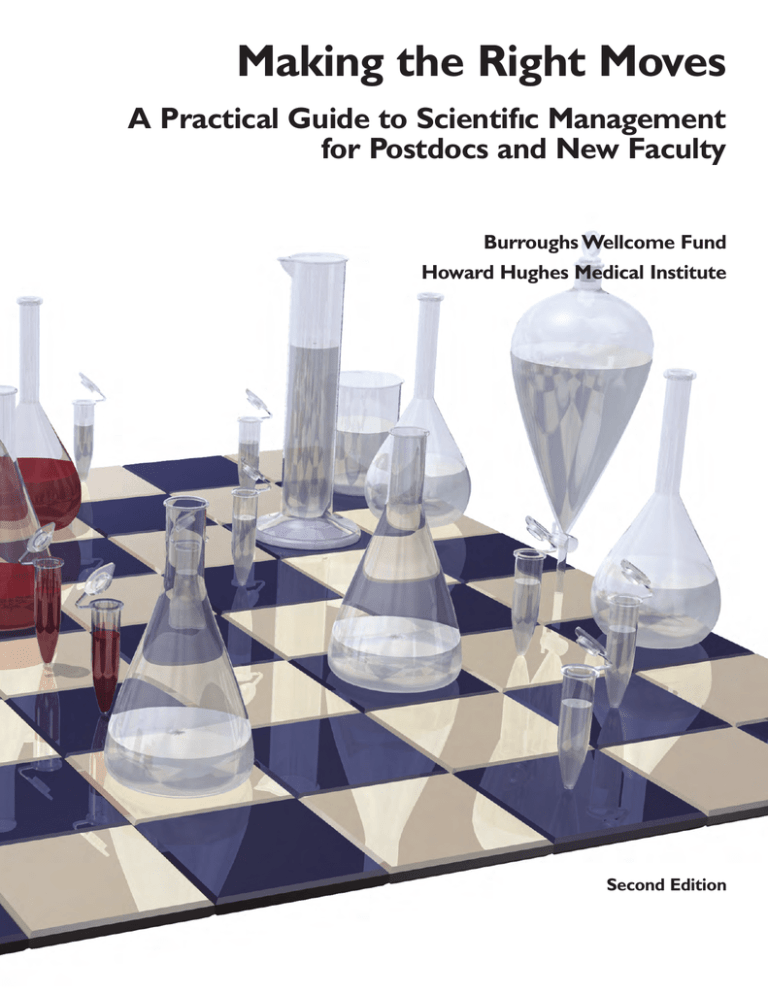
Making the Right Moves A Practical Guide to Scientifıc Management for Postdocs and New Faculty Burroughs Wellcome Fund Howard Hughes Medical Institute Second Edition © 2006 by the Howard Hughes Medical Institute and Burroughs Wellcome Fund All rights reserved. 09 08 07 06 1 2 3 4 5 Permission to use, copy, and distribute this manual or excerpts from this manual is granted provided that (1) the copyright notice above appears in all reproductions; (2) use is for noncommercial educational purposes only; (3) the manual or excerpts are not modified in any way; and (4) no figures or graphic images are used, copied, or distributed separate from accompanying text. Requests beyond that scope should be directed to labmgmt@hhmi.org. The views expressed in this publication are those of its contributors and do not necessarily reflect the views of the Howard Hughes Medical Institute or the Burroughs Wellcome Fund. This manual is also available online at http://www.hhmi.org/labmanagement. Project Developers: Maryrose Franko, Ph.D., and Martin Ionescu-Pioggia, Ph.D. Editor: Laura Bonetta, Ph.D. Managing Editor: Patricia Davenport Production Manager: Dean Trackman Designer: Raw Sienna Digital Writers: Joan Guberman, Judith Saks, Barbara Shapiro, and Marion Torchia Copyeditors: Cay Butler and Kathleen Savory Indexer: Mary E. Coe Burroughs Wellcome Fund 21 T.W. Alexander Drive P.O. Box 13901 Research Triangle Park, North Carolina 27709-3901 http://www.bwfund.org Howard Hughes Medical Institute 4000 Jones Bridge Road Chevy Chase, Maryland 20815-6789 http://www.hhmi.org Chapter 6 TIME MANAGEMENT F rom a practical perspective, one of the most daunting challenges for beginning investigators is learning how to cram an impossible load of new obligations into a 24-hour day. Finding ways to manage the conflicting demands on your time can be key to developing a successful career and a rewarding personal life. This chapter discusses planning strategies that are critical for successful time management, such as defining long- and short-term goals and setting priorities. Tips for day-to-day time management are also presented. The chapter also offers guidance on managing committee service commitments, balancing research and teaching, and juggling the demands of home and work. In addition, it covers issues specific to physicianscientists. STRATEGIES FOR PLANNING YOUR ACTIVITIES Defining Goals Planning is a process that begins with a goal. Once you have set a goal, you can identify the necessary steps to move toward it. Goals come in descending sizes, each of which informs the next: long-term goals (years), intermediate-term goals (months), and short-term goals (weeks and days). Long-term goals are likely to be a combination of tangibles (e.g., faculty promotions) and intangibles (e.g., a satisfying personal life) that may change over time, making goal setting an ongoing process that you should revisit periodically. In defining your long-term goals, you are also defining yourself—who you want to be and how you want to be perceived. Intermediate-term goals, such as publishing a paper, are often composed of many short-term objectives, such as preparing figures for a paper. Short-term goals are the ones written on your weekly and monthly calendars—the small, concrete, finite tasks that can swallow your time. BWF u HHMI 113 Making the Right Moves A Practical Guide to Scientific Management Getting from Here to There Take the time to craft a formal plan, beginning with your long-term goals. Then set interim goals along the way that are realistic indicators of progress. By setting achievable goals, you avoid having too much to do and not knowing where to begin. Accomplishing just one goal can serve as a powerful motivator to tackle the next goal. The key is to identify what matters to you in terms of interests and values and then to apportion your activities throughout the day and week to address all of them. —Richard Reis, Stanford University ‘‘ ‘‘ Write down all your goals, with each achievement tied to a specific time frame. Putting your ideas into words can help refine your thinking and provide a concrete checklist to keep you on target. Every so often, take a look at your plans, reflect on them, and revise them as appropriate to changing circumstances. Priorities shift; be prepared to reevaluate yours but also to defend them. Long-term goals. These goals can be achieved in three to five years. Before jotting down your long-term plans, first ask yourself where you want to be after this stage in your career. For example, if you are a postdoc, do you plan on an academic or applied position? At what type of institution—a research-intensive institution, teaching college, or other? Now ask yourself, “What will I need to accomplish to make myself competitive for that job?” If you are an assistant professor, you probably want to work toward tenure. Knowing when you’ll be up for tenure, ask yourself, “What will I need to do by then—how many papers, invited seminars, professional meetings, and other accomplishments?” Intermediate-term goals. These goals can be achieved in six months to one year. For example, as a postdoc you should be thinking about the experiments needed to complete your next paper or to put together a poster. Completing publishable chunks is an essential intermediate-term goal for faculty. Other such goals are obtaining preliminary results for a grant, putting together a new course, and organizing a meeting. Short-term goals. These goals can be achieved in one week to one month. They include preparing figures for the paper you’re writing, completing an experiment, preparing reagents for the next set of experiments, or writing letters and making phone calls to secure a seminar invitation. If you find it hard to get organized, make a daily or weekly to-do list and check tasks off as you complete them. 114 BWF u HHMI Chapter 6 Time Management Making Choices Saying no, saying yes. One of the simplest things you can do to streamline your life is, for many people, also one of the hardest: Learn to say no. Remember, you can’t do everything, please everyone, be available to everyone, and at the same time be an ideal teacher and scholar. There are certain tasks you must say no to and others for which it’s fine to deliver a less than stellar performance. Making such choices will allow you to focus on doing an outstanding job in what’s truly important to you. Establishing these priorities depends on the intermediate- and longterm goals you have set for yourself. Saying yes judiciously will make it easier for you to say no to things you do not want to do. Because you must accept some administrative assignments, try to make them work for you. Explore the options, and sign up early for duties that either interest you or will work to your advantage professionally. This will then allow you to turn down administrative duties that have less value to you. Maximizing returns. Given the ever-increasing demands on your time, it is impossible to do everything perfectly. Decide which projects need to be completed to near perfection (e.g., your grant application) and which do not (e.g., a draft of a manuscript you are reviewing for a collaborator). Disconnecting. Part of saying no is also not being available on demand. Today’s technological “conveniences” are often needless interruptions to concentration. Any sound strategy for time management involves learning to disconnect—be the master of those tools rather than their servant. MANAGING YOUR TIME DAY TO DAY M any people find long-term goals easy to set—for example, “I want to be a full professor by the age of X.” More difficult is the daily multitasking—managing the flood of small chores that can threaten to drown even the most organized professional. This section covers how to make the most of the time you have. Finding Some Extra Time To be able to focus and think creatively, you need blocks of uninterrupted time. Here are some tips to help you do this: u u Get your e-mail under control. If you’re lucky enough to have administrative help, have an assistant screen messages and flag time-sensitive ones for you. You can also print e-mail messages that require a personal reply and hand write responses during short breaks in your day. Then have your assistant type and send them later. If you don’t have an assistant, set aside specific times of the day for reading and responding to e-mails or read your e-mails at home in the evening. Buy an answering machine or voice-mail service. BWF u HHMI 115 Making the Right Moves A Practical Guide to Scientific Management u u u u Invest in a family cell phone plan to make sure you’re available for family communication and emergencies when you have silenced your office phone. Close your office door or come in early. A sign on your door that reads “Knock if important” lets your students and colleagues know you are in and working, but don’t want to be disturbed. Early hours might buy you precious focused time away from clamoring students and colleagues. Close your lab door. Securing uninterrupted time in the lab is of paramount importance to your career. Make, and keep, appointments with yourself. Find a quiet hideaway and use it on a scheduled basis. This practice trains people to expect you to be inaccessible at predictable times. Rotating Your Tasks If you tend to have difficulty focusing on one task for long periods, you can turn this potential weakness into a strength through multitasking. Make sure that you always have several things to work on (e.g., the introduction to a grant, a paper to review, or a recommendation letter to write), perhaps three or four, and cycle through them with increasing lengths of time. Make sure they are clearly arranged on your desk so that you don’t waste time figuring out what you should do next. Seven (Not So Obvious) Keys to Working and Living Right 1. Learn how to say yes as well as how to say no. It’s easier to say no to unwanted tasks if you have already committed to something you do want to do. 2. Establish your absence as well as your presence. Set a schedule for being physically elsewhere and unavailable, and stick to it. 3. Do a little bit of everything as well as all of one thing. Master the art of multitasking. 4. Determine your tasks as well as your priorities.There are many activities, small and large, that lead to your goal. 5. Work until your time is up as well as until your task is done. Approach every task with the goal of making progress during a specific amount of time, then move on to the next task to maintain forward momentum. 6. Bring some of your home to work as well as some of your work to home.You live in both worlds; look for ways to bring them together (e.g., if you have a long commute, leave home early to beat the traffic and save breakfast and the newspaper for your office). 7. Seek to integrate your professional and personal activities where appropriate as well as to separate work and play where appropriate; doing so can maximize your effectiveness and satisfaction in both areas. Source: Richard M. Reis, Stanford University. 116 BWF u HHMI Chapter 6 Time Management Setting Priorities On the basis of your goals, decide what you need to do and when, and follow the classic KISS rule: Keep It Simple, Stupid. A grid that allows you to rank short-term claims on your attention according to urgency and importance can be a useful tool (see figure 6.1). Try to control the not urgent/not important quadrant. You get relatively little value for the time spent doing tasks in this quadrant. The urgent/ important quadrant puts you in crisis mode, where few people operate best. For maximum efficiency, you should be spending most of your time in the upper righthand quadrant on tasks that are important but not urgent. If it’s important but not urgent, remember your priorities and schedules: u Plan ahead and know your deadlines. u Break large tasks into smaller tasks. u u u Set aside blocks of time for specific tasks. Delegate tasks. Complete tasks on time. Making the Most of the Time You Have It’s important to find ways to make efficient and productive use of your time. Be aware that for some activities, it may not be immediately apparent that your time spent is worthwhile. For example, attending seminars in your department can actually be a productive and efficient use of your time. Not only will you learn new information, but if you ask questions, you will also boost your visibility. Efficiency. Successful people tend to be efficient. They have evolved practices to create blocks of uninterrupted time for “brain work.” Here are some tips to help you make the best use of those parts of the day you control: u u Figure 6.1. Time management grid Create an environment conducive to productivity. Make a place for everything, and put everything in its place; clutter is inefficient. Find or make a quiet space (or time) to work. Know your biological clock, and protect your most productive hours for your writing and designing experiments and other critical tasks. Not Important Not Urgent Urgent Important • Most e-mail • Weekend plans of lab members • The Super Bowl pool • Ongoing experiments • Preparing for a committee meeting • Next month’s grant deadline • “You’ve got mail” alert • Ringing telephone • Inquiring colleague • A lab fire • Tomorrow’s grant deadline Source: Sandra L. Schmid,The Scripps Research Institute, adapted from Stephen R. Covey’s time management matrix in The Seven Habits of Highly Effective People: Powerful Lessons in Personal Change. BWF u HHMI 117 Making the Right Moves A Practical Guide to Scientific Management u u u u ‘‘ u u u During your protected work hours, focus and don’t allow interruptions. Set time limits. Give yourself predetermined amounts of time to complete tasks (e.g., two hours to review a paper). Eliminate unnecessary tasks. Avoid procrastination. Start tasks early—at least in outline. If you have a grant due, write your goals early enough to let your lab staff start gathering relevant data without last-minute panic. If a critical reagent requires a long lead time to produce, start it early enough to make sure it’s ready when you need it. Structure and supervise meetings. Delegate work. Make a quick phone call instead of having an often less efficient back and forth e-mail conversation. Get a high-speed Internet connection at home. Having a high-speed Internet connection at home has revolutionized our lives. I can be home at 5:00, put the kids to bed, get on the PC, and do everything from home. It has really improved our parenting and family abilities with more efficient time management. —Milton Datta, Emory University School of Medicine ‘‘ u Fitting it all in. Successful people also learn to use small units of time, capitalizing on free minutes here and there (in many professions, people bill their time in increments of 15 minutes or less). Returning phone calls, drafting memos, and reviewing your weekly schedule are just a few ways in which you can put a few minutes to work for you throughout the day. The trick is to be prepared when those moments arise by having messages or e-mail, students’ homework, a notepad, and perhaps a cell phone with you. Some tasks, such as reviewing papers and reading science magazines, adapt well to commuting time if you don’t drive. 118 BWF u HHMI Be prepared to take advantage of small chunks of time. In 5 to 10 minutes, you can make a quick phone call, handle an e-mail requiring a personal response, or fill out a form. —Sandra Schmid, The Scripps Research Institute ‘‘ ‘‘ Chapter 6 Time Management Improving Your Lab Staff ’s Time Management Skills Here are some tips for helping your staff work more efficiently: u u u u ‘‘ Establish clear goals and expectations early, starting with simple tasks your staff can handle. Make sure they understand the tasks. Reward and correct them as appropriate, expand the tasks, then repeat the process. Help them seek advice without taking up unnecessary time. Teach them how to describe projects, issues, and problems accurately and efficiently. Develop an agenda for every meeting—and stick to it. Start meetings with a clear description of the purpose of the meeting and when it will end. After meetings, send a “Dear gang” follow-up letter containing a summary and to-do list. Use these informal minutes to start the next meeting and gauge progress. (Meeting minutes are also useful for patent protections in establishing proof of an idea, attribution, and date.) Once the members of your lab learn the importance of time management, you can also delegate to a key staff person the task of summarizing meetings and assigning follow-up actions. Investment of time to train others does pay off in time efficiencies. —Richard Reis, Stanford University —Todd Golub, HHMI and Dana-Farber Cancer Institute ‘‘ When your lab members report to you on a project, request that they first provide some context and then organize what they tell you in concise bullet points of information: “I’m going to tell you about this morning’s experiment. This was the result. This is what I think it means. This is what I plan to do tomorrow.” With this strategy, a five-minute interaction can get you immediately connected to what the person is doing. BWF u HHMI 119 Making the Right Moves A Practical Guide to Scientific Management SPECIAL ISSUES Managing Committee Service Commitments Committee duties can connect you with interesting people—in your department, your institution, and beyond. They can also help bring your research to the attention of your colleagues—a genuine plus for a beginning faculty member. But how can you avoid spreading yourself thin with committee service obligations? Be proactive and seek out committee service that suits your interests and schedule so you can turn down other requests with the legitimate excuse of previous committee commitments. Women and underrepresented minorities need to be particularly good at saying no because they’re frequently asked to serve on committees. Try to volunteer for something that you care about or that would benefit you. For example, the graduate admissions committee is often of great interest to a starting assistant professor. Then use these commitments as a reason to decline other opportunities for committee work that come along. So the next time someone comes and tells you about this great committee that they would like you to sit on, say, “I would really love to do that, but it turns out I just agreed to do this huge graduate admissions committee job. It’s going to be very time-consuming and it’s so important.” And then they will nod understandingly and, hopefully, walk out the door and not ask you again. —Thomas Cech, HHMI Research and Teaching ‘‘ ‘‘ If you’re in a department that values good teaching and you’re thinking about tenure, if you want your course material to be up to date and engaging, or if you are responsible for difficult material you don’t fully understand, you may find yourself dedicating a large portion of your time to teaching at the expense of everything else. For the sake of your research career, you must learn to control your class-related hours. Chapter 13 “Teaching and Course Design,” page 211, offers some strategies on how to do this. Even though it is difficult, you have to set limits for nonresearch tasks and stick to them. When time is up for one task, move on to the next item in your daily planner. This way, you start each day anew without carrying forward serious work deficits that accumulate throughout the week. As a guideline, one senior scientist advises that regardless of how much office work you have, as a beginning principal investigator, you should be spending the equivalent of at least two full days in the laboratory every week. 120 BWF u HHMI Chapter 6 Time Management Special Issues for Physician-Scientists The Triple Load of the Physician-Scientist: Lab, Class, and Clinic Although physician-scientists may have some teaching duties, these duties usually aren’t extensive.The larger challenge for a physician who is running a research lab is balancing lab and clinical time. An even split between the lab and clinic is increasingly rare; it can be as much as 80 percent lab and 20 percent clinic, but it varies considerably from person to person and by the nature of the work. Here are some tips for straddling the lab and the clinic. In the lab: u u u u Consider investing in a lab manager.These individuals usually have an advanced degree or a lot of experience and are thus more expensive, but a good lab manager will help keep the lab on track while you are on clinical duties. Establish a system where you can review the lab members’ notebooks and data even if they are not there (e.g., if clinical duties keep you from being in the lab until late in the evening). Explain to your lab members that you will not be around much when you are on clinical duty.Try to schedule times when you can meet with your students and postdocs to keep yourself apprised of their progress. Focus your research program on what you’re uniquely qualified to do. In the clinic: u u u u Tell patients how you want to be contacted. If you have access to support staff (and many junior faculty do not), use them effectively. Educate nurses or “physician extenders” to do as much of the preparation as possible before your appointments, as well as the follow-up. Learn to tell patients when you have to stop. Make patients and colleagues aware of your dual roles. Remember, in the lab, in the clinic, and at home—the most important thing you need to learn is to be flexible with your priorities. Home and Work: Can You Have It All? This question applies to many professionals in high-pressure careers, including male and female scientists pursuing academic career tracks. Family communication. It helps to start with a supportive partner and family. Have clear discussions about career and personal goals—yours and those of your family—early on. To avoid the resentments of unspoken and unmet expectations, be as explicit as possible about your aspirations with those who are important to you. Shared goals for work and family make compromises easier. BWF u HHMI 121 Making the Right Moves A Practical Guide to Scientific Management In addition to sharing your long-term goals, keep your partner and family aware of your short-term plans and projects. Letting your partner know in advance about an impending grant deadline can buy some understanding. Here are some ways to keep your family informed of your schedule and you involved with your family: u u ‘‘ u Post a calendar at home with your travel dates and big deadlines. Schedule activities with your family and keep those commitments (e.g., Friday date night). Turn business travel into a vacation. Have your partner join you after a scientific meeting and take a few days together to unwind. Involve your partner in your work if he or she is interested. Having partners read over a grant application allows them to contribute, and you benefit from a fresh set of eyes to find typos. One problem I see with clinician-scientists is that the clinic creeps into every day’s work, with phone calls, prescription renewals, acute medical needs, lab follow-up, and management of paperwork. In my experience, it has been valuable for junior faculty to define their availability to the infinite demands of patient care. For example, it may help to limit clinic duties to one full day per week rather than two half days or to choose to do clinical work that can be done in chunks (such as inpatient rounding) and does not require follow-up. —Ann Brown, Duke University School of Medicine ‘‘ u Balancing work and children. Unquestionably, children complicate the equation, but they can also provide the sanity, personal satisfaction, and motivation to make you a more focused and efficient scientist. Few professionals are willing to forgo having children in order to facilitate career advancement, nor should they. Highquality day care, domestic services, and shopping conveniences make raising a family and having a challenging career sustainable and enriching. Indeed, being the boss (e.g., running a lab) can give you the flexibility and the financial resources to make the choices and adjustments necessary to maintain a balanced lifestyle. Here are some tips for balancing work and family life: u 122 BWF u HHMI Take advantage of options for assistance in cooking, cleaning, and other domestic chores, and don’t waste energy feeling guilty. When your budget allows (and in the early years, it may not), buy yourself time: Hire help with housecleaning—even if you can afford only semimonthly scouring of the bathrooms and kitchen. Until then, a messy (but reasonably clean) house won’t hurt you or the kids. Later, a nanny or housekeeper (who also does laundry) is worth the investment. Chapter 6 Time Management u u u u u Eat out with your family once a week or once in a while, even if it’s fast food. This is an easy family-focused activity you can enjoy together outside the house. Pick up carryout meals to eat at home. This break from cooking will stretch the dinner table time you have to share information about everyone’s day and allow you to play with younger children and put them to bed. Teach your children how to help out with age-appropriate chores (e.g., putting their clothes in a hamper, putting away clean laundry, setting the table). When you do cook, keep meals simple and make large quantities that can be frozen in meal-size portions for use throughout the week. If you and your partner both work outside the house, make the best childcare arrangements you can. If you’re away from your child all day, it’s especially important to carve out inviolable family time on evenings or weekends. Is it possible for ambitious scientists to have it all? For those who learn to balance competing demands, the answer is a qualified yes. The key—admittedly easier said than done—is to identify what matters most to you and then to apportion your activities throughout the day and week to address them all. The important thing is to set your priorities, learn to compromise, and be flexible. I don’t sell cookies or gift wrap for my kids’ school; I write checks. I don’t volunteer in their classrooms; I go on one field trip a year, which means a lot to my kids. My family takes a two-week summer vacation, a trip at spring break, and long weekends away. —Sandra Schmid, The Scripps Research Institute RESOURCES ‘‘ ‘‘ Blanchard, Kenneth H., and Spencer Johnson. The One Minute Manager. 10th ed. New York, NY: Berkeley Books, 1983. Boice, Robert. The New Faculty Member: Supporting and Fostering Professional Development. San Francisco, CA: Jossey-Bass, 1992. Covey, Stephen R. The Seven Habits of Highly Effective People: Powerful Lessons in Personal Change. New York, NY: Fireside, Simon & Schuster, 1990. Reis, Richard M. Tomorrow’s Professor: Preparing for Academic Careers in Science and Engineering. New York, NY: IEEE Press, 1997. BWF u HHMI 123
